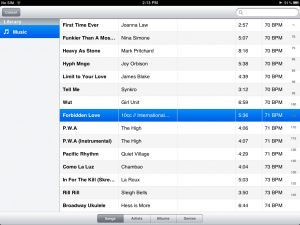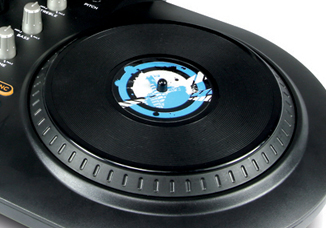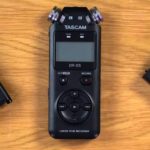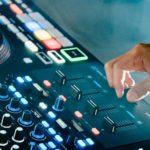On novelty value alone, the Numark iDJ Live nails it. “DJ system for iPad, iPhone or iPod Touch” its box proclaims, with a picture of two decks and a mixer in a smart little casing, with an iPad positioned directly behind it, angled up towards the DJ.
Picking up the box, though, is enough to tell you that this is not a “serious” piece of kit – it just doesn’t weigh enough! But that’s clearly not the point – here is a cheap DJ set-up that lets consumers use their iPads to have a go at DJing. Let’s plug it in and see how well it achieves that goal…
First impressions and setting up
Inside the box, there are some moulded plastic parts that remind me of those build-it-yourself model aeroplane kits, a couple of leads (one separate, one attached to the DJ unit), the unit itself, and an instruction booklet. The booklet recommends you to visit the Numark website for a “list of compatible apps”, but in reality, the only app you can use is Algoriddim’s djay, which you have to buy separately for your iPhone, iPod Touch or iPad, in order to use the system.
The unit itself is a reasonably sized plastic box with ends that mould around two big platters, designed to look like actual records, complete with grooves, a label and a little spindle in the middle. They spin pleasingly and feel like they are going to be fun to use.
The rest of the controls are cheap moulded plastic, although to be fair apart from the scratchy crossfader, they all actually feel good to use. There are 15 buttons and eight knobs, and at first glance it’s clear that only basic DJing is going to be possible from this unit – there are no hot cues, looping controls, effects controls, gain controls (each channel has a volume knob instead of a volume fader), or even mid-range EQs, the unit only having bass and treble.
(Incidentally, if the unit looks familiar to you, that’s because it’s very similar to the Ion Audio iCUE 3 Discover DJ System, Ion Audio being a sister company to Numark.)

So, having downloaded the app and installed it, the next step is to plug everything in and set it all up. The first thing to note is that you can’t charge your iPad and DJ with it at the same time, because of the iDJ Live plugs into the dock. Numark claims three hours’ DJing time on the iPad and six on the iPad 2.
The second thing to note is that the system uses the age-old “hack” of having a splitter cable to allow you to cue one record while playing another to your audience. This effectively uses one of the two channels in the stereo signal for each purpose, so the DJing is done in mono. No big issue – it’s a little-known fact that most club PA systems run in mono anyway – but it limits the sound quality that of the internal audio interface nonetheless.
So you also plug the splitter cable in, plugging your headphones into one output and your speakers into the other. It has two 1/8″ (3.5mm) jacks, so your headphones have to have the smaller style of plug on them, and the easiest speakers to plug in are computer speakers, although you can, of course, plug any speaker/amp you like with the correct cable to go between them and the iDJ Live’s splitter.
Finally, you physically set it all up. Here’s where the moulded plastic parts are turned into a stand. You fold one of them and push the other one into two slots as a brace. It holds the iPad reasonably steadily at an angle that’s good for sitting down and DJing but wrong if you want to stand up. In reality you’ll probably want to find your own way of propping your iPad up, but the supplied stand will get you started. It has to be said that when you tuck it behind the unit, it does look overall like a pretty neat little DJing set-up.
In use
First thing to say is that djay is great software for the iPad, which really reproduces with a lot of accuracy the two-decks-and-a-mixer style of DJing, and over the months since launch has added a lot of fun additions including some excellent effects, as well as refining the workflow with the addition of small tweaks that make all the difference – sorting by BPM is one that springs to mind. So the iDJ Live is in good company here.
When you power up, everything works fine with no configuration other than you having to tell the unit you’re using a splitter cable for headphone cueing. Pressing the big central button brings up your music library, and turning it allows you to pick from the available tracks. Of course, you need your iTunes music synced to your iPad here for this to work, maybe even via iCloud…
Once you’ve found a tune, you press “A” or “B” to load it onto that deck, and if djay hasn’t “seen” that track before, it briefly analyses it before displaying its waveform and loading it (you can choose whether you want it to auto-play or not). Using the jogwheel you can then manipulate the tune to choose a start point, and press the cue button to set that point.
Pressing play or cue then starts the song or plays momentarily from the cue point. Turning off/on the “scratch/search” button alternate jog behaviour between scratch and scrub (ie quickly scanning through a tune, like fast forward or rewind).
They’ve fudged the nudge!
Unfortunately, while the manual says there’s a nudge function here, in that when a track is playing and the jog mode is set to “search”, the jogwheel will nudge the tune for keeping two tunes in perfect time, it doesn’t work like that: instead, the scrub function remains enabled. This makes nudging tunes using the jogs – a basic function of jogwheels – impossible. It needs correcting, for sure. For now though, luckily there are pitch nudge buttons too.

More niggles: the unit has bass and treble but the EQs in the software are bass/mid/treble: What happens is the mid just gets left, so there’s no way of controlling 1/3rd of the EQ at all from the iDJ Live. There’s no way of changing the headphones volume on the unit, which is quite annoying (although you can work around it by setting the volumes and master volumes so they headphones sound OK and then compensating on your main amp volume setting). Another gripe is that the mapping on the jogs is not one-to-one, so you can spin the wheel back and it carries on turning happily while the music plays on in the other direction! (Watch the accompanying video for a demo of this.)
So the hardware is not perfect, and the software also still lacks in one or two areas – I’d like to see it incorporate the custom “key” metadata added by popular harmonic mixing software like Mixed in Key, and then also add a keylock button, both of which would make the increasingly popular key mixing style of DJing possible. But actually, the latest version of djay is very good, with intuitive effects, good looping, and multiple cue points, all easily accessible via the touchscreen.
A new way of DJing
On the plus side, you actually end up DJing by using the unit and the screen, so many of the shortcomings aren’t really too much of a worry. The flimsy little plastic mount actually works excellently when it’s all in place and the iPad is fitted into its slots; the main output lead holds the unit and the iPad closely together, and it’s therefore easy to use the touchscreen controls on the iPad without everything slipping or bending.
As I say, you, therefore, end up using the hardware controller for some tasks, and using the touchscreen of the iPad for others, happily mixing and matching as you feel most comfortable. As such, it generally works OK as a basic DJ system, and will get you through a set or two – as long as your battery holds out, that is.
Conclusion
This is not made or sold as a serious DJing system, which is just as well, because it isn’t. It falls down in too many fundamental areas to be that. However, for DJing at parties, or every now and then for a bit of fun, it’s a neat little system that won’t break the bank. In fact, it’s more than neat – it’s downright flashy!
But for learning to DJ properly on, the broken nudge feature, the poor jogwheel-to-software mapping and the flawed EQ implementation mean that it can’t be recommended as your only DJ set-up. As a second system, fine, but if you’re starting out and think this might do you as your only set-up, you should definitely look elsewhere.
As proof that DJing is not only possible but downright sensible with a tablet computer acting as library and screen plus a control surface for jogs ‘n’ knobs, though, it’s downright revolutionary. It makes complete sense to not have a laptop with you, and as iPads and similar develop and become more capable (better processors for quicker song analysis, better audio outs for instance), there’s no reason why this couldn’t become the norm for mobile, party and bar/lounge DJs.
Maybe DJs will even just roll up with an iPad and plug it into a standard installation mixer/controller in days to come. Who knows? For now, though, with the iDJ Live (and now the Vestax Spin) both able to act as iPad djay software controllers, this could be the start of a whole new way of DJing digitally.
Neat little system or pointless toy? Let us know your thoughts in the comments!








